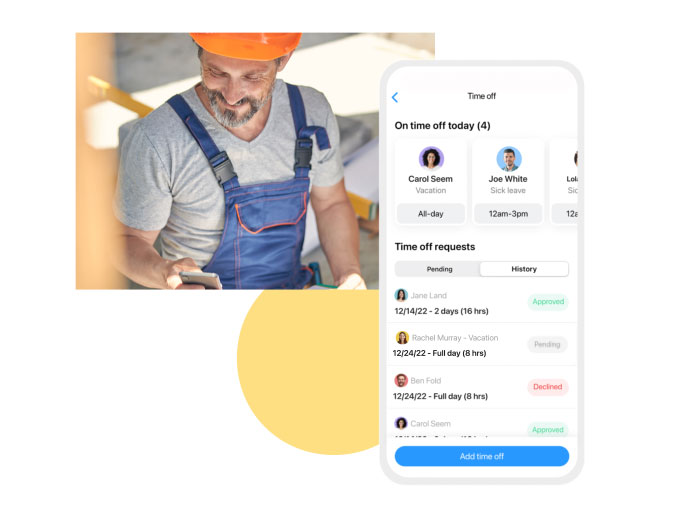Workers in every industry get sick sometimes. When employees are ill, some may be able to stay home.
Some may feel pressure to go to work. Companies in the United States offer a varying amount of sick time off.
This can range from a few days to paid time off that can be used for any reason, including illness or vacation time.
Here, we take a look at the sick time offered and taken in the US, as well as the impact it has on businesses.
How Many Sick Days Per Year Are American Workers Allocated?
It’s worth bearing in mind that the average number of sick days taken by workers per year can vary year from year. We saw this during 2020 and 2021 when suddenly large numbers of workers needed long-term absences from work to deal with covid-related illness. We also need to consider how many employees have access to employee benefits that allow them to take time off.
Pro Tip
Employee vacation tracking software like Connecteam is the best way to manage all things PTO from your phone, tablet, or computer. Employees can request time off directly from the app and you can track balances, create time off policies, and view all leave requests in a centralized location.
Get started with Connecteam for free today!
Unpaid sick leave
Many US workers are protected by The Family and Medical Leave Act (FMLA), a federal rule that grants up to 12 weeks of unpaid leave each year. An employee’s job and group benefits are protected during this leave. Workers can use the leave if they are seriously ill, if they need to care for a sick relative, or to take time off with a newborn or newly adopted child.
To qualify for FMLA leave, employees must have been with their current employer for at least a year. They also need to have worked 1,250 hours or more over the last year and work at a location where their employer has at least 50 workers within 75 miles.
Paid sick leave
In addition, some states require companies to provide paid sick days. For example, California requires 24 hours or 3 days of paid sick leave every year. In Connecticut, workers can get up to 40 hours of paid sick leave per year. Arizona, Michigan, New Jersey, Oregon, Massachusetts, the District of Columbia, Maryland, Rhode Island, Vermont, and Washington also have their own sick day rules.
Further to what is required by the FMLA and state laws, many employers voluntarily choose to offer paid sick leave. According to a 2022 survey by the Society for Human Resource Management (SHRM), 96% of employers offer sick leave.
In March 2022, the Bureau of Labor Statistics reported that paid sick leave was received by
- 79% of civilian workers (civilian workers are those who are not employed by the military or federal government and who are not agricultural workers.)
- 77% of private industry employees
- 81% of state and local government employees
- 99% of primary, secondary, and special education teachers.
Contract type also affected access to sick leave. For example, 99% of full-time local and state government workers had access to paid sick time, compared with 48% of part-time workers in the same sector.
Anyone can get sick multiple times in a year. However, of the civilian workers receiving sick leave in 2021, 69% had a fixed number of paid sick days. The average number of sick days workers had access to also varied:
- After 1 year of service, the average amount of paid sick leave was 7 days.
- After 20 years of service, the average amount increased to 8 days.
Larger companies give workers access to more days off for illness. In companies with over 500 employees, workers received an average of 9 days of sick leave after 5 years of service. This increased to 10 days off after 20 years of service.
By comparison, companies with under 50 employees gave their workers 6 days of sick leave after 1 year, rising to 7 days of sick leave after 20 years of service.
Paid time off (PTO)
Some companies offer a more general paid time off (PTO) benefit., which workers can use however they wish. PTO is different from sick time because workers can use it however they wish. They can use this to heal from an illness, to go on vacation, or to take time off for other reasons. As with any time off, PTO requires workers to seek approval in advance for an absence and get approved for time off.
There are a few types of PTO. There is limited PTO, for example, where employees have a specific number of PTO days. They may have 10 days to use throughout the year, for example, to travel or to go to appointments.
Some companies allow limited PTO to be rolled over. For example, if a worker with 10 days off takes 2 days this year, they would have 18 days of PTO to use the following year.
Another option is unlimited PTO, famously offered by companies like Netflix and LinkedIn. In theory, this allows employees to take any amount of time off they want, as long as they can complete their work duties and contribute to their teams. In reality, there may be written or unwritten rules about how much time a worker can take off.
One in 5 companies also offers paid mental health days beyond sick days. Workers who have been working hard and feel stress or fatigue can ask for a day or part of a day off to sleep in or relax. In these cases, they would use an absence request process to give advance notice to their workplace. Mental health days allow workers to prevent burnout and reduce anxiety.
You might also read our average vacations days per year guide.
Manage PTO with the click of a button
A paid time off policy helps boost engagement, attracts the top talents to join your company, and helps your bottom line. It’s a no-brainer, and you can do it so easily with Conneccteam!
How Many Sick Days Per Year Do American Workers Take?
Americans may have access to a varying number of paid sick days at work, but how many do they take? Not many. According to a Statista survey of adults in work or study in 2022,
- 26% took no sick days off
- 6% took 1 sick day off
- 15% took no more than 3 days off.
A poll of 6,600 hourly workers conducted by Shift Project found that 65% of workers did not take sick time between September and November 2021. These workers worked while sick. Of these, it was found that
- 30% did not have access to paid sick leave
- 55% said they needed the earnings
- 40% said they couldn’t find anyone to cover their shift
- 44% reported being worried they might be in trouble if they called in sick.

Why Does the Average Number of Sick Days Per Year Matter?
Whether we’re looking at the average sick days per year offered by companies or the number of sick days workers actually take off, the metrics matter. This is for a few reasons.
Your benefits help you stay competitive
Offering a number of sick days per year or unlimited paid sick leave improves your company’s brand. Workers want to know their employers will take care of them when they’re sick. Offering paid sick leave to workers can therefore help you attract and retain talent.
Workers get sick
The CDC reports that 6 in 10 Americans have a chronic medical condition. Even something as simple as a cold or flu can leave a worker unable to work for 7-10 days at a time. Understanding the average number of sick days per year means you can offer the benefits your employees need. This prevents them from coming to work sick.
Pro Tip
Make sure your employees know how to call in sick. Whether it’s with an email, phone call, text message, or via a time tracking app like Connecteam, workers need to know your preferred method to avoid miscommunication.
Sick days keep your company healthier
When employees come to work sick, they can pass on the flu, colds, and other communicable diseases. As more people get sick, it gets harder to fill shifts and keep productivity high. But when employees receive sick days off, they can stay home and protect other workers and customers.
Sick days could save lives
An American Journal of Preventive Medicine study in 2022 found that even an extra hour of sick leave could extend employees’ lives. The same study found that if US counties required 40 hours of paid sick leave for employees, worker mortality could drop by over 5%.
Sick days help fight absenteeism
Good communication is important, especially when workers get sick. You don’t want a situation where workers don’t show up and don’t call because you don’t have a sick leave policy. This can leave you scrambling to cover shifts.
Offering Sick Days: Creating a Sick Leave Policy
Your workers will eventually need to take a day off for illness, so you’ll want to plan ahead. Here’s how.
Talk to lawyers and leadership
Get familiar with the FMLA and consult with an employment lawyer about state laws that may require paid time off. Then, consider whether your company can offer paid time off, and how much time you can offer. This may require ongoing conversations with leadership, your financial team, and HR.
Consider your budget and the competition
You may also want to look at how much time workers have been taking off so far and how many sick days your competition offers. You should also consider your budget. Aim to offer an attractive sick leave policy that meets employee needs without hurting your bottom line. Make sure that your policy clearly states which of an employee’s family members are also covered.
Have a system
Let your employees know what to do if they are sick. Whether you offer paid time off or not, have a policy for calling in sick and for managing time off. Create a system for covering work if an employee can’t come in at the last minute. You can use Connecteam’s employee training app to show workers what they need to do if they need to call in sick, and an employee PTO tracker to monitor sick time.

Be ready to pivot
Keep in mind that in many cases workers may not be able to give you much notice if they’re ill. They may wake up sick, so you’ll need to be ready to pivot. You may want to have open shifts or use a system like Connecteam Work Chat. This will let you quickly send out requests to workers who may be available to take on extra work when a colleague is unwell.
Keep track
In addition to a sick leave policy, you may want to create an absence management strategy. This helps you track and reduce absenteeism that could be affecting morale and productivity. Connecteam has a free attendance policy template you can use to get started. It can help you distinguish between legitimate and unacceptable absence requests.
Conclusion
On average workers have 7-8 sick days available to them, but many do not use their days off. Your organization needs to comply with the FMLA to offer work-protected unpaid days off. There may also be state laws to consider.
However, you might also want to consider a paid time off policy. Offering either a set number of paid sick days or unlimited PTO lets workers take care of their health. It also lets you take care of your organization as a whole, keeping productivity high.
The #1 Employee Management App
Keep your team on track by managing time off and sick days with Connecteam. Try it for free today. No credit card required.




